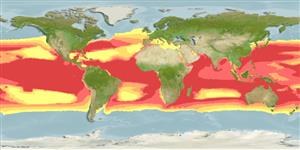Preferred temperature (Ref.
123201): 18.2 - 27.6, mean 24.7 °C (based on 46871 cells).
Phylogenetic diversity index (Ref.
82804): PD
50 = 1.0000 [Uniqueness, from 0.5 = low to 2.0 = high].
Bayesian length-weight: a=0.00275 (0.00197 - 0.00385), b=3.17 (3.07 - 3.27), in cm total length, based on LWR estimates for this species (Ref.
93245).
Trofisk nivå (Ref.
69278): 4.3 ±0.2 se; based on diet studies.
Resiliens (Ref.
120179): Mellan, lägsta populationsfördubblingstid 1,4-4,4 år (K=0.34; tm=1-2 y; tmax >4; Fec=6 million).
Prior r = 0.84, 95% CL = 0.55 - 1.26, Based on 1 full stock assessment.
Fishing Vulnerability (Ref.
59153): Moderate to high vulnerability (46 of 100).
🛈
Climate Vulnerability (Ref.
125649): Very high vulnerability (76 of 100).
🛈
Nutrients (Ref.
124155): Calcium = 34.8 [17.2, 70.3] mg/100g; Iron = 1.34 [0.70, 2.53] mg/100g; Protein = 21.8 [20.5, 23.1] %; Omega3 = 0.183 [0.092, 0.379] g/100g; Selenium = 28 [13, 64] μg/100g; VitaminA = 6.92 [2.08, 25.10] μg/100g; Zinc = 0.423 [0.273, 0.649] mg/100g (wet weight);
